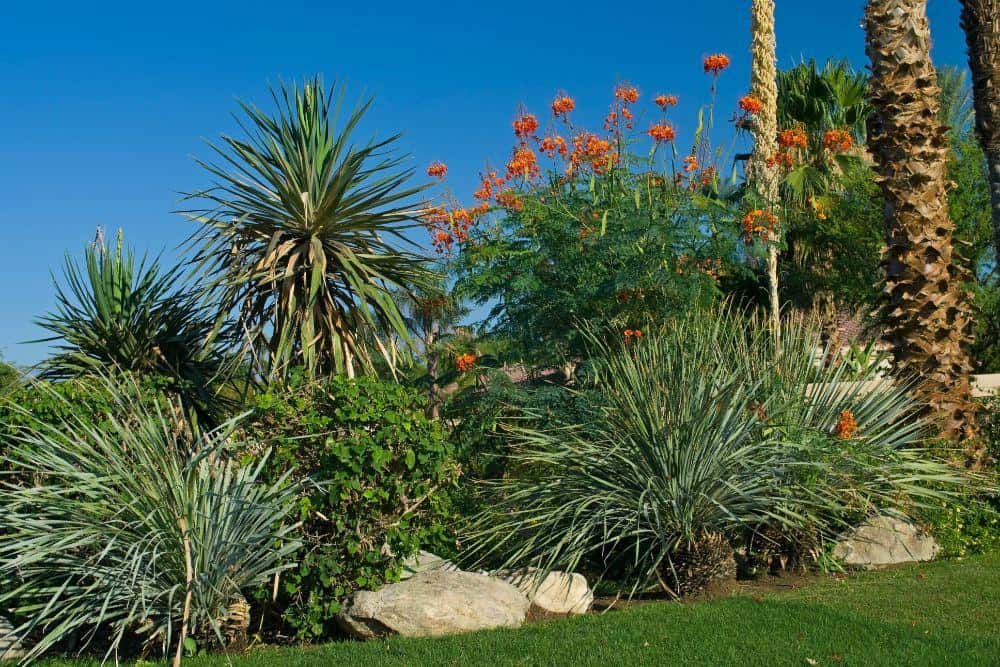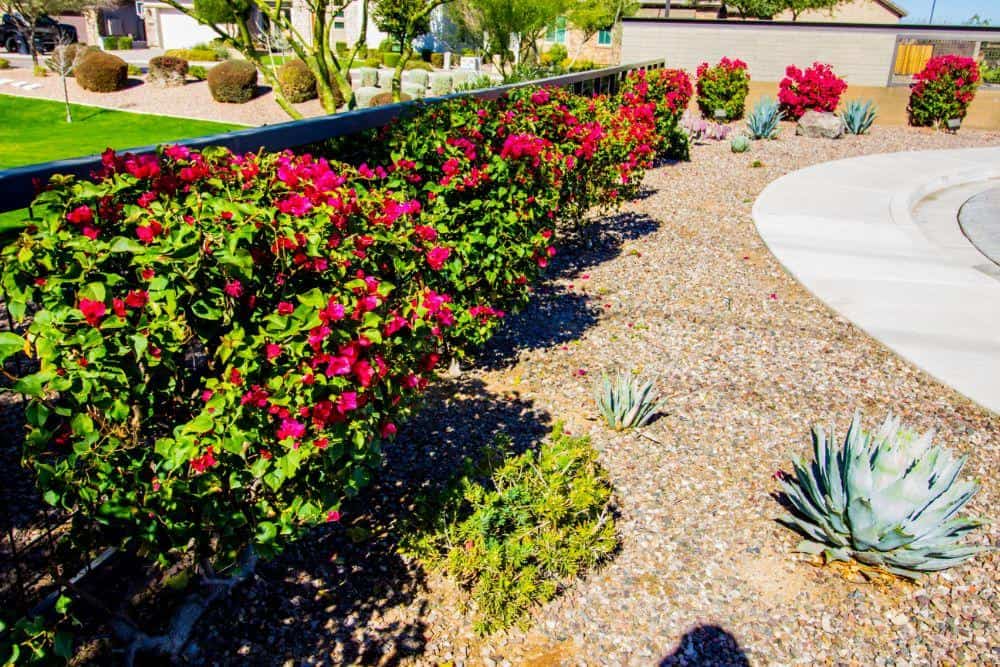Desert landscaping is a needed service throughout the United States. This niche in landscaping focuses on creating picturesque and practical landscapes in arid desert climates.
Offering specialized landscaping services in desert climates is a smart idea. Did you know that Arizona has been in a drought state since 1994? Meanwhile, California has seen four consecutive years of droughts as of 2022. In fact, nearly 50% of the United States is in a drought, meaning many people can benefit from hiring a desert landscaper to help their outdoor spaces conserve water and look fantastic.
Before starting a desert landscaping business, get to know the difference between traditional landscaping and desert landscaping to provide the right solutions to clients living in states with high heat, little rainfall, and sandy or stony soil.
Desert landscaping is a niche of the landscaping business that focuses on dry areas and desert landscapes of the United States.
There are four deserts in the United States, the Great Basin, Chihuahuan, Mojave, and Sonoran, all of which are in western parts of the United States. That said, desert landscapers also offer services in areas with desert climates throughout the country.
The main difference between desert landscaping and a traditional landscaping business can be boiled down to a different outlook on water conservation efforts.
Desert landscapes are classified by sandy, stony, or clay soil, low moisture, and high heat, so all desert landscape contractors must consider garden and lawn elements that withstand droughts. Traditional landscaping businesses are typically less mindful about selecting drought-tolerant plants, artificial turf, and other vital services that desert landscapers offer.

Agave Plants do Well in Arid Environments
If you’re starting a desert landscaping business, become knowledgeable about desert soil and water requirements, plant selection, maintenance, artificial turf, and hardscapes. Below, we’ll go into detail about each.
Drought-prone areas like desert climates need landscaping features with low water requirements. Water consumption should always be top of mind when starting a desert landscaping business.
It’s a landscaper's job to recommend the best solutions that fit the client's query and the climate of the landscape. This means selecting drought-tolerant plants that don’t require frequent or a lot of care. Or suggesting clients install artificial turf or hardscapes in place of greenery.
Desert climates typically have stony, sandy, or clay soil, so desert landscapers should know how each soil type can affect plant selection and timelines for installation.
Landscapers in deserts typically add a new layer of soil to promote a sound root system for new plants. However, a solution like hardscapes or artificial turf may be better suited to the location, depending on the soil type.
Desert landscaping maintenance differs somewhat drastically from traditional landscaping maintenance. Most landscaping maintenance includes mowing, weeding, fertilizing, pruning, and watering.
In a desert landscape, there’s less lawn greenery for mowing, pruning requirements are fewer, and the selected plants shouldn’t require much in terms of fertilizing, especially if they’re native plants. Instead, maintenance includes regular weeding, removing dust or sand build-up around irrigation systems, and watering.
Plant selection is an essential part of desert landscaping because the chosen plants should be hardy and drought-tolerant while still providing suitable outdoor greenery your clients prefer.
The best plants to choose for desert landscapes are ones that are native to the area. Why? Because native plants are used to high heat, low water, and the soil types of the area.
Desert landscapers should also be aware of non-native plants that are highly adaptive to desert climates.
The best desert plants for arid landscapes are ones that thrive in high-heat and low-water environments. So, what plants do well in the hot sun? Some of the best drought-tolerant plants used in desert landscaping include the following:
There’s a common misconception that desert landscaping is only for cacti, succulents, and rocks. However, many drought-tolerant plants have foliage and bear bright-colored flowers that can change an arid desert landscape into a backyard oasis.

Desert Landscaping Involves the User of Many Beautiful Flowering Plants
The grass can be greener on a homeowner's side of the street if they want artificial turf. Artificial turf is fake grass, so it never needs watering or mowing. This is a fantastic option for large front lawns or big backyards that could use a splash of color without fearing it turning brown in a desert climate.
Typically, traditional landscapers don’t use artificial turf often. Desert landscapers, on the other hand, will install a significant amount of artificial turf in their career.
Hardscapes are common in both traditional landscaping and desert landscaping, though techniques will vary depending on the client and the climate.
Hardscaping refers to all the things, other than plants, that make up a backyard, front lawn, or garden. Artificial turf, technically, is hardscaping since it’s not actually alive. Other hardscaping seen in desert landscaping include rock gardens, walkways, decks, built-in furniture, or paver installations.
Desert landscapers will see more requests for outdoor kitchens than traditional landscapers. Desert climates benefit from year-round temperatures suitable for outdoor kitchens, so this hardscaping feature is an excellent option for clients that want to utilize their outdoor space better.
Desert landscaping services are an essential service that allows homeowners in desert climates to maximize their outdoor spaces. Plus, desert landscaping helps conserve water by removing thirsty, non-native plants and replacing them with drought-resistant greenery.

Low Maintenance Doesn’t Mean Zero Maintenance: Landscapers are Still Needed to Keep Desert Flora Healthy and Looking Great
Alongside traditional landscaping services, desert landscapers can offer xeriscaping, desert maintenance, irrigation installation or repairs, and exterior design.
For those asking, how do you landscape in an arid climate? The answer is xeriscaping. Xeriscaping is a type of landscaping style where gardeners intentionally select and place garden elements that require little or no irrigation.
As mentioned above, understanding water conservation is a big part of running a desert landscaping business. Xeriscaping helps to create a drought-tolerant landscape by using hardy native plants, reducing grass coverage, and utilizing drip irrigation or other water-saving techniques that provide adequate moisture for plants to thrive.
Other elements include installing hardscapes that cast shadows onto plants that prefer partial full sunlight and using organic mulch to reduce water evaporation.
Desert landscapers offer maintenance services like lawn care, plant care, and weed control. Plus, landscapers specializing in desert climates usually provide maintenance services for irrigation systems to prevent dust or sand from building up over time.
Like traditional landscaping, desert landscapers offer maintenance services like mowing lawns, watering plants, pruning, fertilizing, reapplying mulch, and pulling weeds. Landscapers also provide tree services like tree trimming, removal, or installation.
Installing and maintaining an irrigation system is one of the things that desert landscape businesses do best. Desert landscapers offer services like drip irrigation installation, sprinkler repairs, and maintenance.
Drip irrigation systems are the best way to conserve water and adequately provide enough moisture to plants.

Some Plants May Require Drip Irrigation to Thrive
Over time, dust and sand may build up in your sprinkler or irrigation systems, so desert landscapers also maintain a client’s watering system to ensure it’s working at total efficiency.
Landscape design and installation is an essential service offered by desert landscaping businesses.
Whether a client wants to use hardscapes like an outdoor kitchen instead of natural greenery or they want a lush garden oasis blooming with flowers, designing the perfect space is part of the job.
Here is where a landscaper's knowledge about design, watering requirements, native and adaptive plants, soil types, and hardscaping all come together.
